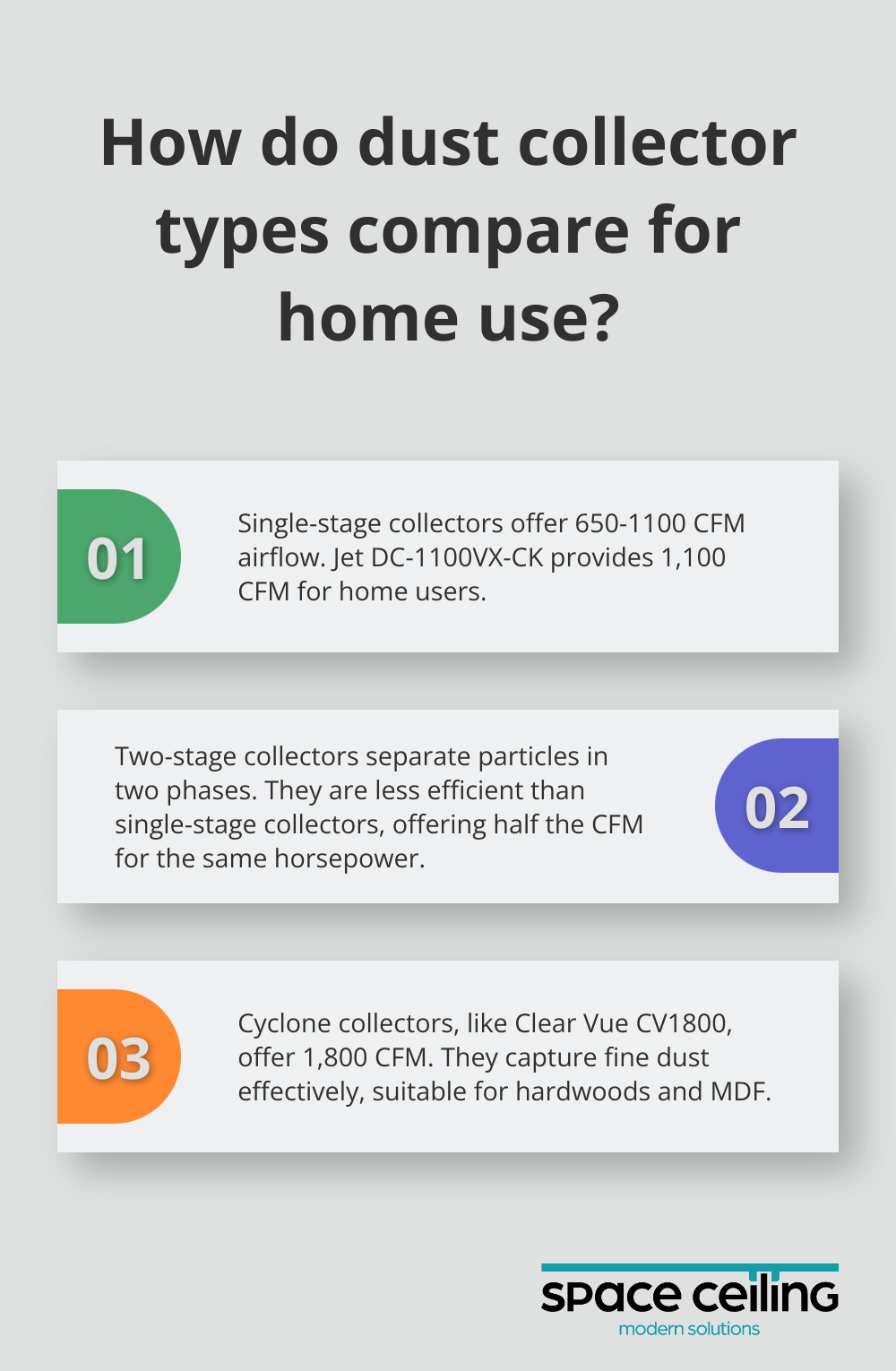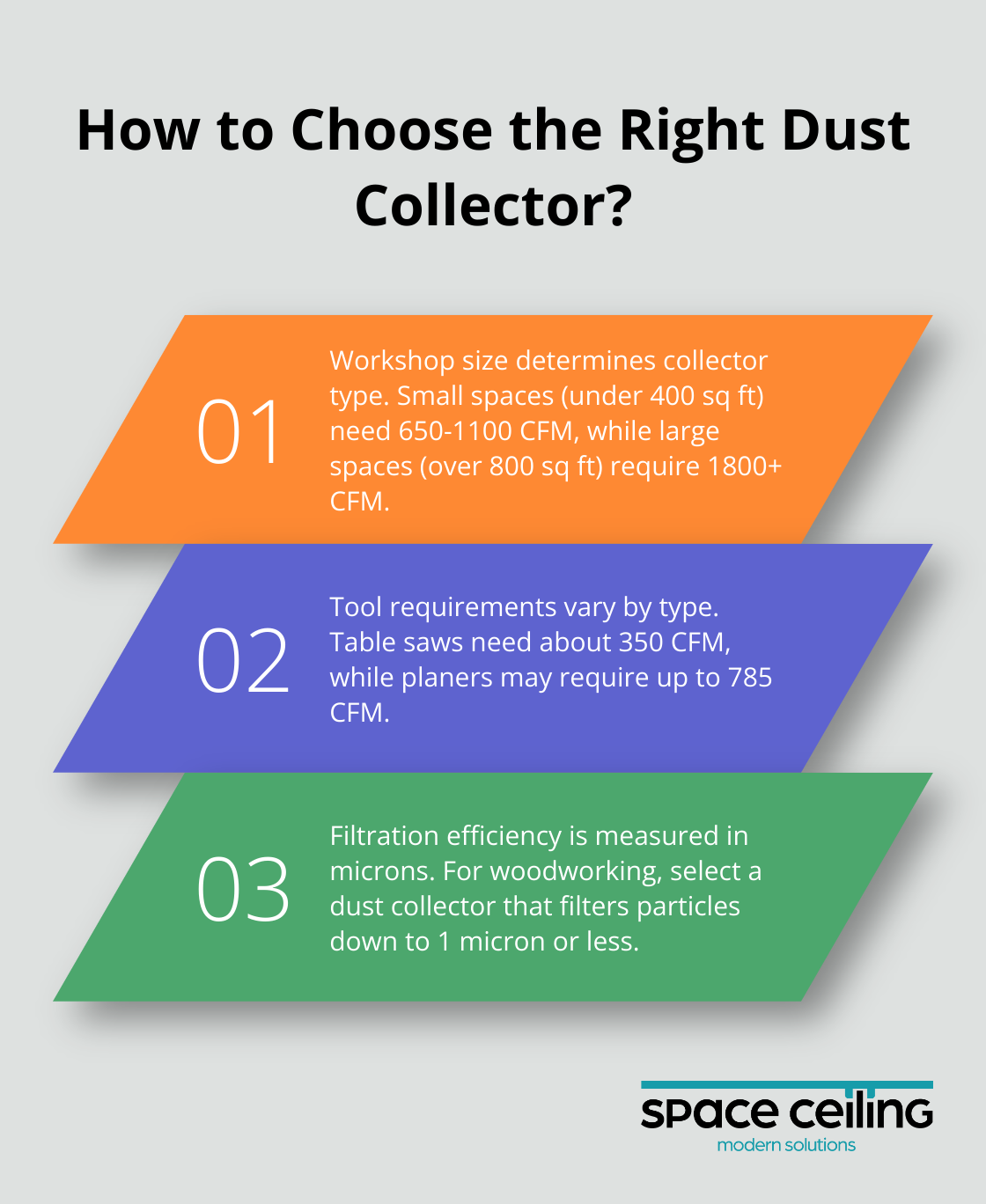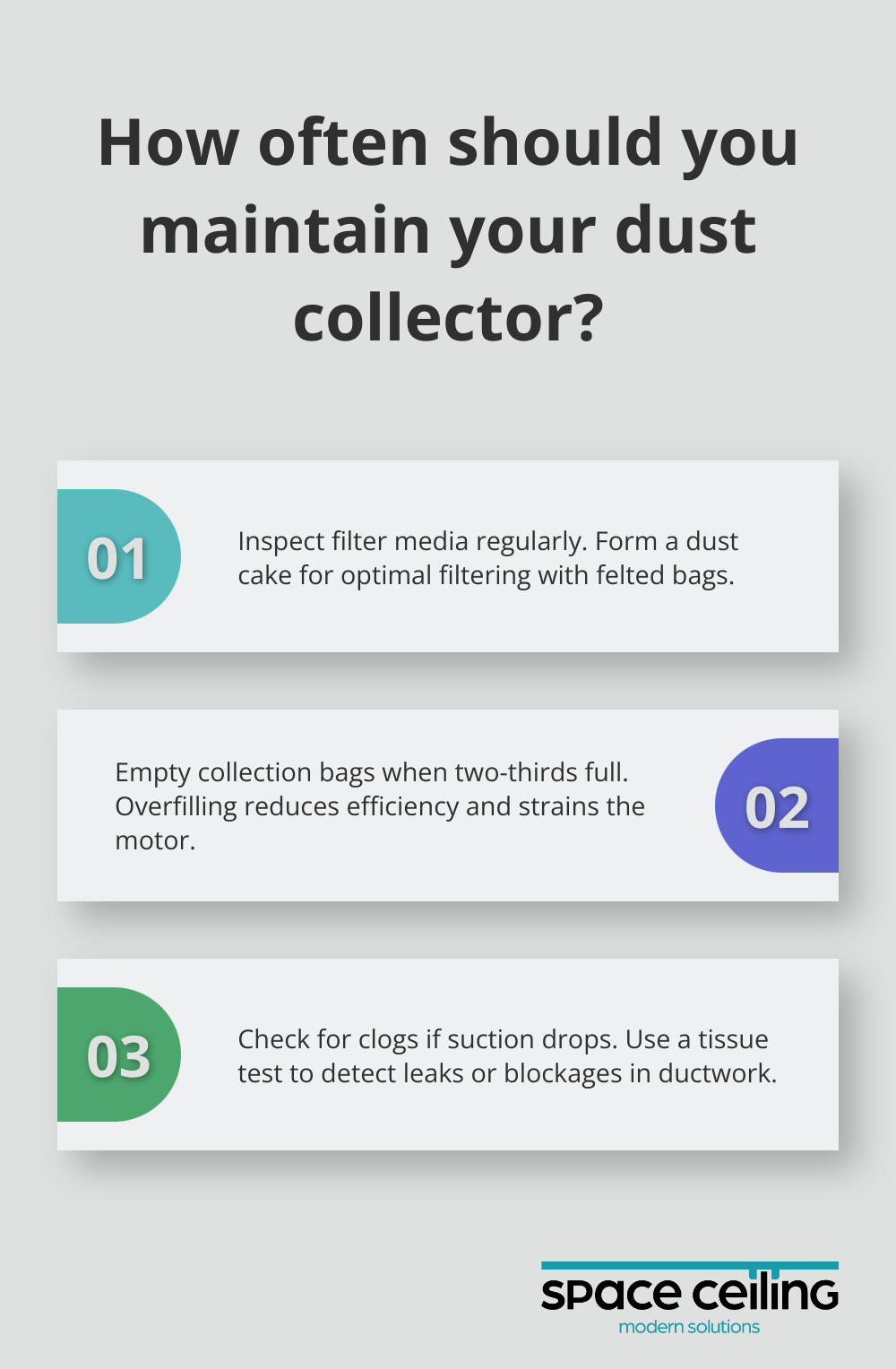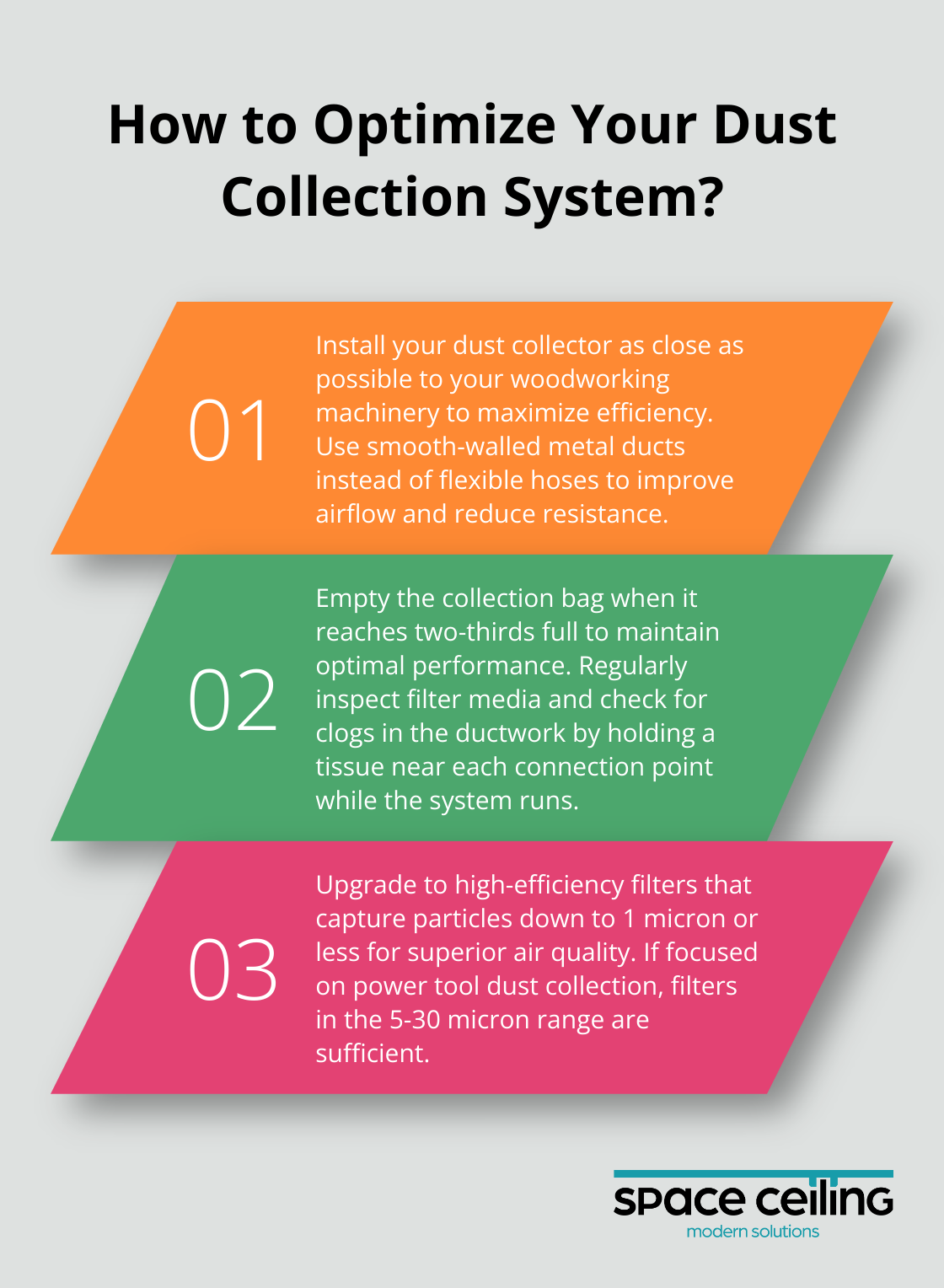At Space Ceiling, we understand the importance of clean air in your home workshop. A dust collector is an essential tool for maintaining a healthy and safe environment while working on your projects.
In this guide, we’ll explore the various types of dust collectors for home use and help you choose the right one for your needs. We’ll cover key factors to consider, from workshop size to filtration efficiency, ensuring you make an informed decision.
What Dust Collector Types Work Best at Home?
At Space Ceiling, we know the importance of clean air in your home workshop. Let’s explore the main types of dust collectors suitable for home use.
Single-Stage Dust Collectors
Single-stage collectors use a motor-powered impeller to pull dust-laden air through a filter or bag. These units excel in small to medium-sized spaces and perform well with tools that produce larger chips (like planers or jointers). However, they might struggle with fine dust from sanders.

A typical single-stage collector for home use offers around 650-1100 CFM (cubic feet per minute) of airflow. This suffices for most hobbyist woodworkers. The Jet DC-1100VX-CK provides 1,100 CFM and is popular among home users for its balance of power and affordability.
Two-Stage Dust Collectors
Two-stage dust collectors separate the collection process into two phases. First, larger particles separate in a cyclone or drop-out box. Then, the air passes through a filter to capture finer dust. This design improves efficiency and extends filter life.
A single stage collector has almost double the CFM rating for round about half the price of a cyclone of the same horsepower.
Cyclone Dust Collectors
Cyclone dust extractors are two-stage dust collectors that can provide a superior result compared to a traditional dust collector, which only has one stage. They capture both large and small particles with high efficiency. While traditionally used in industrial settings, smaller cyclone models now suit home workshops.
The Clear Vue CV1800 is a popular cyclone model for home use, offering 1,800 CFM. It captures fine dust effectively, making it an excellent choice for those who frequently work with hardwoods or MDF.
Ambient Air Cleaners
Ambient air cleaners play a vital role in maintaining overall air quality in your workshop. They filter the air continuously, removing fine dust particles that may have escaped your primary dust collection system.
The Jet AFS-1000B air filtration system can cycle the air in a 20′ x 20′ workshop up to 8 times per hour. It complements any dust collection setup well, especially in smaller spaces where dust tends to linger.
When selecting a dust collector for your home workshop, consider the size of your space, the types of tools you use most frequently, and your budget. A good dust collection system not only keeps your workshop clean but also protects your health and safety while you work on your projects.
Now that we’ve covered the types of dust collectors, let’s move on to the factors you should consider when choosing the right one for your needs.
How to Pick the Perfect Dust Collector
At Space Ceiling, we understand the importance of selecting the right dust collector for your home workshop. A proper dust collection system transforms a cluttered workspace into a clean, safe, and efficient environment. Let’s explore the key factors you need to consider when choosing your dust collector.
Size Matters: Match Collector to Workshop
The size of your workshop directly impacts the type of dust collector you need. Small spaces (under 400 square feet) often work well with a portable dust collector offering 650-1100 CFM. Medium-sized workshops (400-800 square feet) typically require a 1.5-2 HP system with 1100-1600 CFM. Larger spaces (over 800 square feet) often need a 3 HP or greater system with 1800+ CFM.
Tool Requirements: Know Your Dust Producers
Different tools produce varying amounts and types of dust. Sanders and routers generate fine dust that requires high CFM and good filtration. Table saws and planers produce larger chips and require strong suction. List your most-used tools and their CFM requirements. Add these up to determine your minimum CFM needs. (A typical table saw needs about 350 CFM, while a planer might require 785 CFM.)
Airflow and Static Pressure: The Dynamic Duo
Airflow and static pressure work together to determine a dust collector’s effectiveness. While CFM measures volume, static pressure indicates the system’s ability to overcome resistance in ductwork. Two factors ultimately govern the performance of your dust collector: airflow and static pressure.
Filtration: Prioritize Air Quality
Filtration efficiency is measured in microns. For woodworking, try to select a dust collector that can filter particles down to 1 micron or less. If the goal is to collect dust from most power tools, 5-30 microns will be fine. If the goal is to protect your lungs, get an air cleaner with better filtration.
Noise Levels: Protect Your Hearing
Dust collectors can be noisy, with some models exceeding 85 decibels. Extended exposure to noise above this level can cause hearing damage. Look for models that operate below 80 decibels for a more comfortable working environment. Some manufacturers offer noise reduction packages that can decrease sound levels by up to 50% (a significant improvement for your workshop’s acoustics).

Now that we’ve covered the essential factors for choosing a dust collector, let’s move on to some practical tips for installation and maintenance to ensure your new system operates at peak efficiency.
How to Install and Maintain Your Dust Collector
Strategic Placement for Efficiency
Position your dust collector as close as possible to the source of emission-your lathe, grinder, or other woodworking machinery. This placement improves overall system efficiency. For cyclone collectors, ensure adequate vertical clearance. Single-stage collectors need space around the unit for easy bag changes.
Effective Ducting Techniques
Use smooth-walled metal ducts to maximize airflow. These ducts offer less resistance than flexible hoses, which can increase airflow. Match your main duct size to the inlet of your dust collector. Reduce branch line sizes gradually as you move away from the collector. This technique maintains air velocity and prevents clogs. Install blast gates at each machine to direct airflow where needed.
Regular Maintenance for Optimal Performance
Inspect filter media regularly. In most applications with felted bags, forming a dust cake is a desirable sign of optimal filtering. For baghouse systems, empty the collection bag when it reaches two-thirds full. Overfilling reduces efficiency and can strain the motor. Check for clogs in the ductwork if you notice a drop in suction. A simple test involves holding a tissue near each connection point while the system runs. If the tissue doesn’t stick, you might have a leak or blockage.
Noise Reduction Strategies
Dust collectors can produce high noise levels. Try to select models that operate below 80 decibels for a more comfortable working environment. Some manufacturers offer noise reduction packages that can decrease sound levels significantly. Consider installing sound-absorbing panels around your dust collector to further reduce noise in your workshop.
Filtration Upgrades
Improve your dust collector’s performance by upgrading to high-efficiency filters. Filters that capture particles down to 1 micron or less provide superior air quality. If your primary goal is to collect dust from power tools, filters in the 5-30 micron range will suffice. For lung protection, opt for an air cleaner with better filtration capabilities.

Final Thoughts
The right dust collector for your home workshop impacts your work environment and health. You should consider your workshop size, tools, and dust types when making your choice. Airflow, static pressure, and filtration efficiency determine the effectiveness of your dust collection system.

A quality dust collector in your home keeps your workspace clean and protects your respiratory health. Proper installation and regular maintenance ensure your system operates at peak efficiency. This creates a safer and more enjoyable woodworking experience.
At Space Ceiling, we understand the importance of a clean environment in any space. We specialize in transforming ceilings and walls with innovative stretch ceiling solutions. For those looking to enhance their home or workspace beyond dust collection, we invite you to explore our range of modern ceiling and wall solutions.
Originally posted on January 7, 2025 @ 3:08 am



